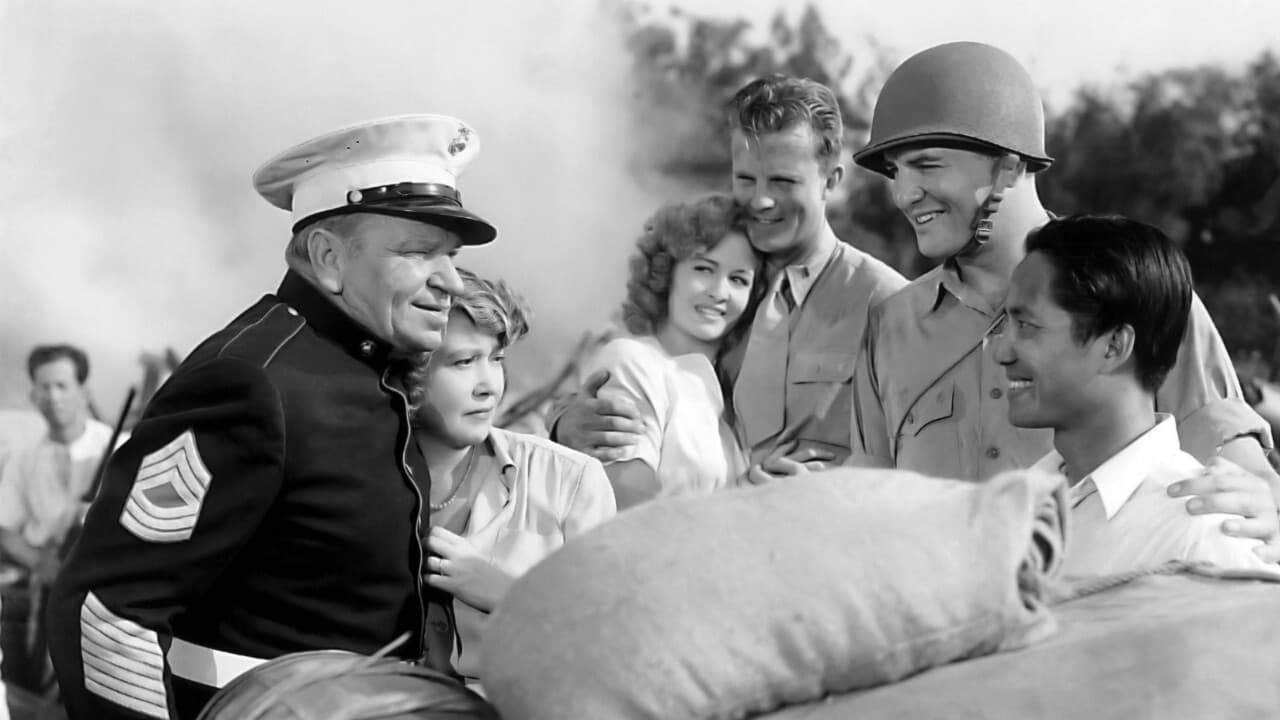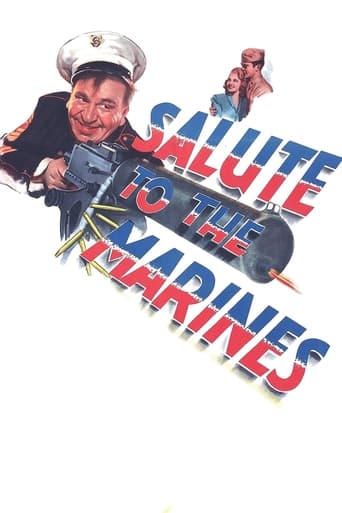

Well, I am a fan of the Marine Corps. True, I spent my four-year military career in the Coast Guard but it was just as rugged as the Marine Corps. It was very nice to be served breakfast in bed by the attractive, blond, seventeen-year-old Swedish maids but there must be no expression in Swedish for "medium rare" because they kept fouling up the steak and eggs. But I taught the Marines at Camp Lejeune for several years and they were among the best of students. When they're sharp, they're really sharp. It's also the only service in which the officers' dress uniforms were less gaudy than the enlisted man's.With that prologue out of the way I can now go on to say that Wallace Beery is no marine. My God, is he sloppy. His whole presence is one pile of flab upon another. He was fine as the comically sly Long John Silver but as a by-the-book top sergeant, he's plain incredible. It's almost painful, watching him rearrange the manifold dimples and gyri of his face into one or another expression.The movie, told mostly in flashback, begins in 1941 in the Philippines. Beery's job, as it must be in all such movies, is to bear down on his men and kick them into shape, the Filipino troops included, before he retires. That impending retirement is an event he dreads because he has never won any "battle decorations." He gets his chance. He retires at the proper time but just as he's finding out that inactivity doesn't suit him the Japanese invade the Philippine Islands pari passu. The "bandy legged Nips" and "monkeys" conquer town after town, forcing all the civilians to flee ahead of them. A determined Beery struggles into his dress blue blouse, mobilizes the American and Filipino troops, and stops the enemy long enough for the women and children to escape across the bridge.They're successful despite the bombs delivered by Japanese airplanes. The Japanese airplanes are dull-colored Vought Vindicators, an obsolete American dive bomber of the period, called disparagingly by pilots the "Vibrator" or "Wind Indicator." The Vindicator also plays itself, when American airplanes rush to the rescue of the beleaguered bridge defenders.Fans of old movies may enjoy it. There are a lot of familiar names in the cast but you won't notice them on the screen. The kids may get a kick out of it. But it's really made for Saturday afternoons when people went to the movies and didn't really care much about what was on the screen. William Manchester -- historian, journalist, and biographer of John F. Kennedy -- claimed that he was seduced into joining the Marines after seeing the snazzy uniforms in "The Shores of Tripoli." One look at Wallace Beery wrestling to get into his tent-sized blouse, and Manchester would have joined the Coast Guard.
... View MoreMGM did this 1943 film in color which was rare doing wartime in those years for any studio to use. Probably 20th Century Fox filmed in color the most, still even their output was limited.Salute To The Marines stars Wallace Beery in one of his few color features and he brings his gruff, but lovable persona into the part of a training sergeant who is stationed in the Phillipines training new recruits for jungle combat which was thought by some to be inevitable. In fact a very farsighted commandant of the Marine Corps John Lejeune determined back in the early Twenties that the Marine Corps special mission was for amphibious landings. This is what the Beery character is working at when he gets an assignment to train Filipino civilians to fight.But a character like Beery would NEVER have been training anyone. The plot premise is that Beery, a thirty year veteran of the Corps would have missed every combat engagement in the Marines had which included Mexico, World War I, Haiti, Nicaragua etc. Now somewhere down the line he'd have been assigned some action or he wouldn't be training anyone, let alone rise to the rank of Sergeant Major.Still train he does and his civilian trainees prove adequate to the task even though they're not the most disciplined bunch.The climax is when the Japanese come Beery also proves adequate in fighting a delaying action after the Japanese bomb the church where he and wife Fay Bainter are attending services. This was on the same day where the Japanese were also doing a job on Pearl Harbor. MGM did a far better film a year earlier about the Phillipine campaign and the last stand on Bataan with Robert Taylor. That one holds up far better than Salute To The Marines.Shoehorned into the story is a kindly German store owner played by Reginald Owen who shows his true Nazi colors as the first Japanese troops land. Beery makes short work of him. The US Marines deserved a far better film than Salute To The Marines which is a dated relic of dubious propaganda value even then.
... View MoreFirst one needs to remember this film was made DURING the war. Anti Japanese resentment following Pearl Harbor and things like the Bataan Death March were running high. And make no mistake, this film is pretty heavy on the anti Japanese message.But that is also one of the things that makes it interesting. It is a glimpse into how people at the time were actually thinking. And while the "dirty japs" were portrayed as squinty, murdering savages we must remember that at the time it wasn't a completely unfair criticism.The film is also unique in that it has a light "comedy" aspect to it. Wallace Beery manages something like an Archie Bunker quality. Probably much needed comic relief given that the news from the war was not always uplifting.But the final thing one needs to keep in mind is the purpose of this film and ones like it. It was designed to unify the nation against a common enemy. And that is how wars are won. And if the worst thing that happens is our enemies are portrayed in a negative light, well that is hardly the worst thing that happens during wars.
... View MoreFirst of all, the Marine who forgot his extra shoelaces would have been verbally chewed out with foul language, probably a physical beating, and doing extra chores. The sergeant would not be giving any rational explanation why you should be carrying extra shoe laces. Back in those days, sergeants did not have to give any logical, practical, reasonable explanations for stuff like that. They tell you to do something,and you did it.Like the movie The War against Mrs. Hadley, it is totally impossible for children of enlisted men and NCOs to have a relationship with officers. The same thing could be said for people of different economic backgrounds to marry each other. Let's face it America was a social class/caste system based the monetary system and political and religious ideologies. Almost all of the officers for the 19th and 20th centuries came from the upper and rich classes families. They only marry people within their social, political, and economic classes. Even today, there is no contact between the officers, NCOs, and enlisted particularly their children when they are off duty and rich people do not marry people from the lower social and economic backgrounds plus the kind of job you have. Why do you think Goucho Marx made fun of the rich people in many of his movies because he knew what they were really like (Bush, Rockefellers, Vanderbilts, Rothchilds, Duponts, etc).Om his speech the ex-sergeant told the local population, that people are sick, they see a doctor. Well, back in those days the true is many people could not afford a doctor. Doesn't that familiar today? Finally, some of the air combat scenes were used in the 1977 movie Midway starring Henry Fonda and Charles Heston. I wonder why they don't show more movies like that and the War against Ms. Hadley more often? I have never heard of them until I accidentally run across them.
... View More